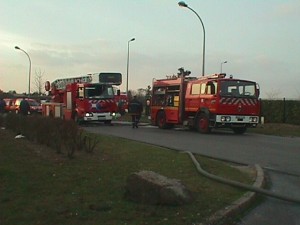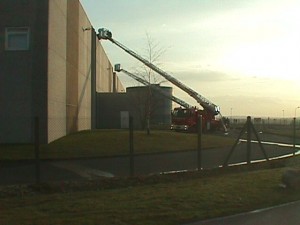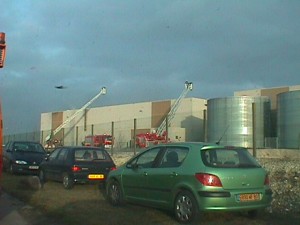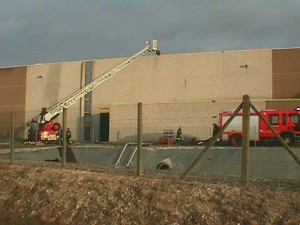At 3:15 pm, fire broke out on the asphalt surfacing of the roof atop a warehouse containing sports equipment subsequent to a subcontractor’s intervention to patch roof leaks. Despite a technician’s attempt to contain the blaze with an extinguisher, flames fanned by the wind continued to spread. The crew foreman notified the facility’s management, which ordered the evacuation of all 120 employees and contacted the local fire station. The electricity company secured the site. Upon their arrival at 3:30 pm, first responders observed that the fire had engulfed 5,000 m² of roof, destroyed domed enclosures and skylights, and threatened the inside of the warehouse, whose sprinkler network had been activated. A thick cloud of smoke enveloped the premises. Fire-fighters deployed 2 protective nozzles inside the storage unit and were able to control the blaze by 4:30 pm using a nozzle mounted on a pivoting ladder. The fire extinction water reached the facility’s stormwater drain network and was channelled into a buffer tank. Since no valve had been installed, a portion of this water spilled into an infiltration basin and penetrated into the ground during the course of the accident, well before analyses of water remaining in the buffer tank actually authorised ground infiltration. The emergency team conducted surveys by means of a thermal camera at 10 pm, and the operator set up a site monitoring operation for the night-time. The next day, the emergency crew did not detect any abnormal CO content readings inside the burned building. The installation resumed its activity two days hence once the state of building structures could be assessed by a specialised firm. The fire caused no injuries, yet many building elements were burned or deteriorated by the heat (roof surfacing, concrete plinths, skylights, domed enclosures, cabling, overhead lighting, etc.), and moreover some stored products sustained water damage.
According to the operator, blowtorches used during the works caused the ignition. The operator thus implemented a fire prevention plan including a hot work permit procedure along with fire extinction water confinement practices. He also audited all electrical installations and ensured compliance of the warehouse roof with the T30/1 fire resistance standard.








